Gonorrhea 2024
Gonorrhea – Annual Report 2024
The national surveillance of gonorrhea at Statens Serum Institut (SSI) is based on data extracted from the Danish Microbiology Database (MiBa) and on clinical notifications via the SEI2 system (see below). MiBa contains data on results obtained by culture and/or PCR or other nucleic acid amplification techniques (NAT), as all Danish clinical microbiology departments (KMAs) perform combined NAT for Neisseria gonorrhoeae and Chlamydia trachomatis.
If multiple positive samples are found in the same person, a new gonorrhea case is defined when more than 21 days have passed between positive findings. A negative testing episode is also defined by more than 21 days between negative results. The surveillance of gonorrhea is supplemented by antimicrobial resistance testing of Neisseria gonorrhoeae isolates submitted to the Department of Bacteria, Parasites & Fungi (BPS), Infectious Preparedness, SSI.
In addition to the laboratory-based surveillance, it is mandatory by law for the treating physicians to report all gonorrhea cases to the Notification System for Infectious Diseases, Department of Infectious Disease Epidemiology and Prevention, SSI. Since 2022, this has been done electronically via SEI2. The clinical notification system requests information not available from laboratory data, such as mode of transmission, sexual orientation, country of infection, and HIV status.

In 2024, 5,112 gonorrhea cases were registered in MiBa across 365,291 test episodes. This represents an 8% decrease in both the number of testing episodes and the number of gonorrhea cases compared with 2023, resulting in an unchanged positivity rate of 1.4%. The reporting rate increased slightly from 75% in 2023 to 79% in 2024. The 2024 numbers indicate that the annual number of new gonorrhea cases has stabilized at a new, lower level following the sharp rise observed in 2022. Similarly, a steep decline in chlamydia testing episodes has been observed since 2022.
Sex, mode of transmission, sexual orientation and country of infection
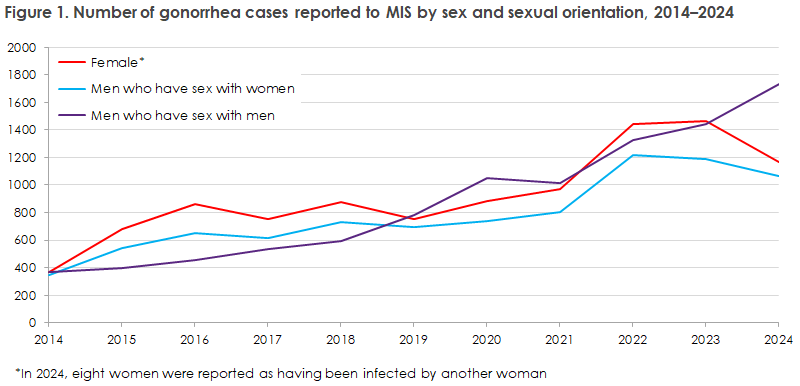
The 5,112 cases were distributed among 1,504 women and 3,608 men. Of these, 4,040 cases were clinically notified, showing a clear increase among men who have sex with men (MSM) and a decrease among men who have sex with women (MSW) and women, Figure 1. In eight cases, transmission was reported between two women (13 in 2023). There were 17 cases among pregnant women (25 in 2023) and 37 cases among sex workers (28 in 2023). Eleven cases were reported among transgender persons (21 in 2023). Origin was specified in 4,038 reports, of which 73% were born in Denmark and 27% abroad.
Information on country of infection was available for 3,996 episodes, with 10% reported as acquired abroad (8% in 2023). In 2024, 382 cases were reported as acquired abroad across 56 countries, most frequently Spain, Germany, Thailand, France, the USA, and Italy. A larger share of cases among men (11%) than women (5%) were acquired abroad. By sexual orientation, 9% of MSW and 13% of MSM were infected abroad.

The total number of gonorrhea episodes among men recorded in MiBa remained virtually unchanged from 2023 to 2024, whereas there was a 24% decrease among women. In the 15–29-year age group, cases among women fell by 33% (from 1,431 in 2023 to 965 in 2024). Among men, there was a decline in the 15–24 age group, while other age groups showed either no change or small increases. For both men and women, increases were seen among those over 45 years, whereas declines of varying magnitude occurred among women in all other age groups. In 2024, men accounted for 71% of all registered gonorrhea episodes — a six percentage point increase compared with 2023.
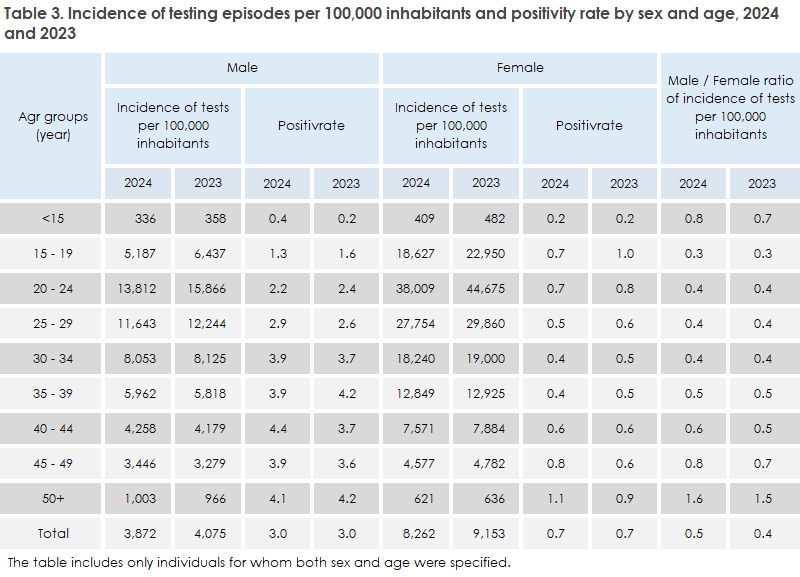
In 2024, there was a decrease in testing activity for both men and women (table 3), but women were still tested more than twice as often as men. In the 15–29-year age group, a larger drop in testing was seen, especially among women. Despite this, the positivity rate decreased among those aged 15–29 (except for men aged 25–29). The highest testing activity in 2024 was again among 20–24-year-olds, with 38,009 tests per 100,000 women and 13,812 per 100,000 men. Overall, there was no change in positivity rate between 2023 and 2024 despite the reduced testing activity. The male-to-female ratio of testing episodes increased slightly from 0.4 to 0.5. Men again had a significantly higher positivity rate than women — 3% vs. 0.7%.
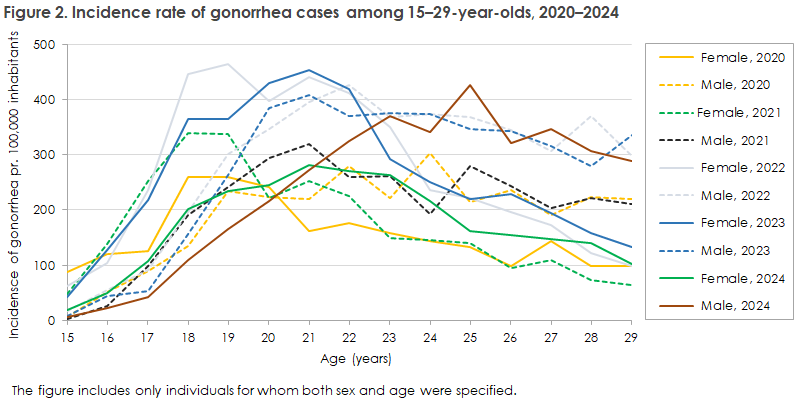
A marked drop in incidence rates was observed (figure 2) in 2024, especially among women aged 15–25 years, where previously high rates among 18–22-year-olds were sharply reduced in 2024.
Among men, there was a downward trend in those aged 15–23 years and a more stable pattern among 24–29-year-olds.
Gonorrhea among children
In 2024, ten cases were recorded among persons under 15 years (7 in 2023). Several of these were eye infections in newborns caused by transmission from the mother during childbirth.
HIV and PrEP-treatment
HIV status was known for 54% of all reported gonorrhea cases in 2024 (47% in 2023). Among 4,036 reported cases, 5% were among people with known HIV, <0.1% with newly acquired HIV, and 48% among HIV-negative persons. In 2024, 60% of reported HIV-negative MSM were receiving PrEP treatment (59% in 2023).
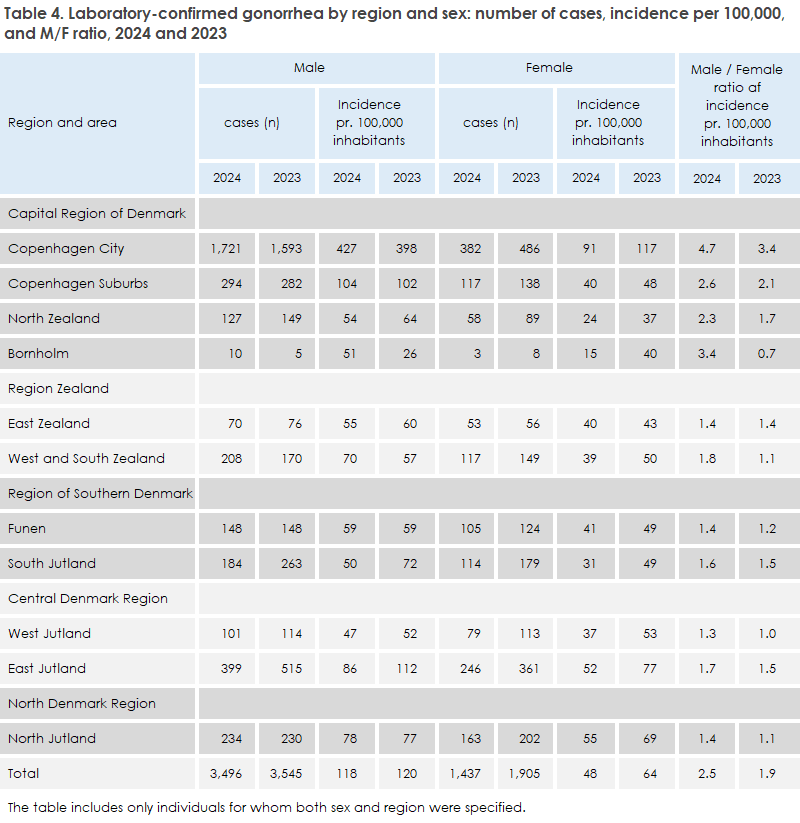
The incidence rate declined in West and South Zealand, Bornholm, and Copenhagen city and suburbs among women but increased among men (table 4). In other regions, there was a general decline for both sexes, except in North Jutland, East Zealand, and Funen, where the male incidence rate remained unchanged compared to 2023. There was a clear increase in the male-to-female incidence ratio across all regions (except East Zealand), reflecting the decline in female incidence not mirrored among men. The highest incidence rates were again seen in Copenhagen city: 427 per 100,000 men and 91 per 100,000 women.

Nationwide, testing activity decreased for both men and women, most markedly among women (table 5). Despite this, the positivity rate was lower in 2024 than in 2023 among women, while it rose slightly among men from 3.0% to 3.1%. The highest positivity rate among men was in Copenhagen city (4.4%), and among women in North Jutland (0.8%).
Unusual anatomical locations
In 2024, gonorrhea was also detected in non-traditional anatomical sites: eyes, joint fluid, and ascitic fluid in 25 cases. The usual anatomical sites are the urogenital tract, the anorectal region, and the throat.
Antimicrobial resistance
In 2024, 2,006 isolates of N. gonorrhoeae (NG) from 1,802 episodes were tested at SSI as part of national resistance surveillance (compared to 2,660 isolates from 2,152 episodes in 2023). Isolates with a MIS notification within 60 days of sampling had known transmission source and sexual orientation, which was the case for 1,516 isolates.
NG isolates were tested for minimum inhibitory concentration (MIC) at SSI, and EUCAST breakpoints were used to determine resistance and susceptibility. Testing included azithromycin, ceftriaxone, ciprofloxacin, and penicillinase production. Isolates with intermediate resistance to ciprofloxacin were categorized as resistant.

In 2024 there was a small decline in the number of isolates received for surveillance, which corresponded with the fall in gonorrhea cases. The share of isolates from women also declined.
Azithromycin resistance decreased from 6% to 3.6%, while ciprofloxacin resistance rose from 45% to 60%, which is the highest level since 2011. The proportion of isolates producing penicillinase remained unchanged from 2023.
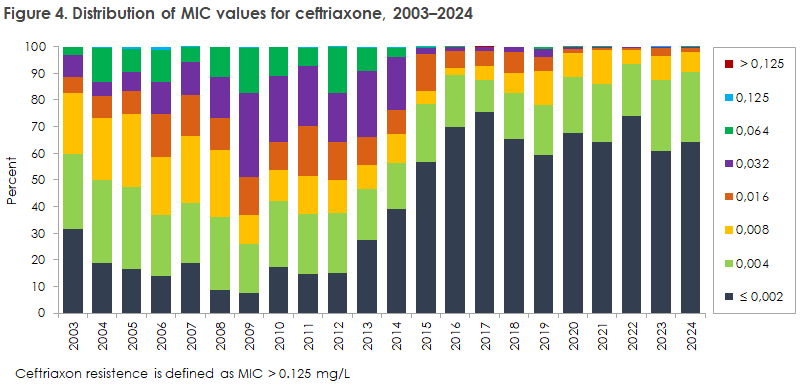
No ceftriaxone-resistant isolates were detected in 2024, and the MIC distribution remained similar to previous years.


An increase in ciprofloxacin-resistant gonococci was seen among MSW and women, while MSM showed a small decline (table 6A and 6B). The decrease in azithromycin resistance (figure 3) contributed to a lower proportion of isolates resistant to both azithromycin and ciprofloxacin. However, the overall increase in ciprofloxacin resistance led to a smaller proportion of isolates susceptible to both drugs.
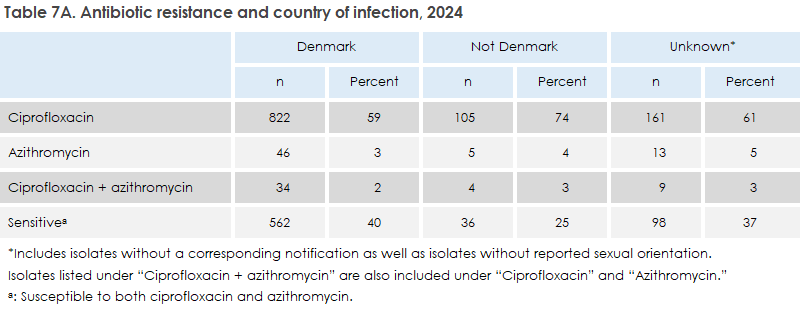
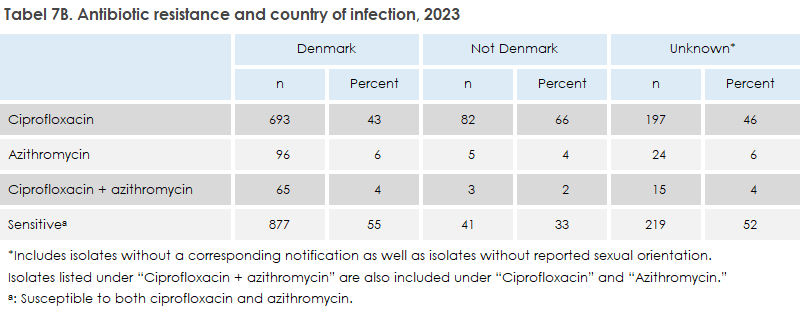
Again in 2024, azithromycin and ciprofloxacin resistance were more common in cases acquired abroad than in those acquired in Denmark. There was a larger relative increase in ciprofloxacin resistance among domestically acquired cases (from 43% in 2023 to 59% in 2024) compared with imported cases (from 66% in 2023 to 74% in 2024).